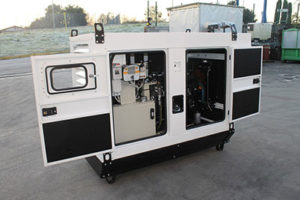Mobile machinery design has its challenges, but it has many benefits as well. A hydraulic pump need not mount near a hydraulic reservoir, and in fact, could be many feet away. A pump may be near the transmission of the vehicle or at a PTO shaft near the truck’s front bumper. As well, valves and components often find themselves mounted where it most makes sense for performance and function. These freedoms are rarely enjoyed with industrial hydraulics, where the power unit and major components are centralized.

Mobile HPU from Power Hydraulik
Hydraulic power units are used in mobile machinery, of course, and are not limited to industrial environments. A mobile hydraulic power unit is very similar to its industrial kin, but with various unique design considerations. Often mounted to the bed of a heavy vehicle (or trailer), it’s obvious a mobile hydraulic power unit is mounted out in free air and exposed to the worst of the outdoor environment. A power unit design must encompass corrosion resistance first and foremost, using a combination of stainless steel, composites and rust-resistant paints.
A corollary to rust resistance is the water-resistant nature of the electrical components, such as valve coils, sensors and engine control components. Electrical connections and interfaces must resist water-related damage, so, typically, advanced connection technology is used, such as Deutsch or Metri-Pak connections. These connection styles are available in a wide range of sizes and pin-counts while allowing for up to IP69K water protection, which can resist high-pressure hot water spray.
Just as the outdoors can be wet, the subjection to temperature extremes requires thought as well. A diesel engine has its own heat dissipation requirements, so care must be taken to prevent exhaust heat from contaminating hydraulic oil (yes, heat is a form of contamination). Mounting a hydraulic reservoir near the diesel exhaust is a recipe for disaster, especially when the summer heat is already straining the hydraulic power unit.
Very few mobile machines make do with no hydraulic cooler. Hydraulic liquid-to-air coolers for mobile hydraulic power units are some of the largest available. Having to deal with ambient heat on top of everyday inefficiencies and pressure drop necessitates high-power cooling. 12-volt fans are sometimes unable to keep up, so occasionally hydraulic motors are used to power fans, yielding tornado-like air power to help dissipate heat.
Mobile equipment must be powerful, reliable and economical, but often only two of those criteria are considered. Although any hydraulic power unit exists to transmit hydraulic energy to perform work, the unique mobile operating environment makes designing for mobile hydraulic power units a challenge.
Filed Under: Fluid Power Basics, Mobile Hydraulic Tips, Pumps & Motors